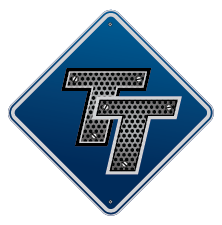I Need To Learn The Log Book Rules
Topic 33204 | Page 1
First, stop over thinking it. Do not even THINK about trying to understand splits, and other nuanced stuff until you have a handle on the biggest part of it.
Going to explain it as simply as I can, without nuance or squirrel side trips.
In an 8 day span, you have 70 hours to be on duty, or driving.
Once you start your clock for the day, you have a 14 hour window, to complete the following:
11 hours of driving (mandatory 30 minute break before 8 hours is up)
The on duty/driving hours I use today, come off the 70 hour bank
After I hit my max drive/on duty time for the day, I am required to take 10 consecutive hours off duty. I was always told this had to include 8 hours in the sleeper.
Once that 10 hour break is over, I will get access to the next 14 hours of duty clock, and the cycle repeats, until you have zero hours on your 70 hour bank.
There are two ways to get time "back" into your 70 hour bank, a 34 hour reset, where you are off duty for 34 hours straight. No interruptions on your clock. This will give you back a full 70 hour bank.
The second way to get time back into your 70, is by "recapturing time" commonly called "running on recaps." For a recap, the hours that I use on duty/driving today, will be re deposited into my 70 hour bank, at 12:01am, one week from tomorrow.
There is some differing viewpoints on wether recaps or resets are better, and I say it depends on the situation. If I want to run solely on recaps, and never run out my 70, then I could only spend 8.5 hours per day in on duty/drive status.
Yes I know there is nuance that I didn't cover. Yes I'm aware of splits. No, I'm not going to confuse anyone until they have the main time concept down. As always, someone feel free to correct me if I am wrong.
OWI:
Operating While Intoxicated
NaeNae I like the way you explained it. I'd like to add, with your same caveat of correct me if I'm wrong, but I don't think the 10 hour break has to include any sleeper time, it just has to be off duty, sleeper, or any combo of the two adding up to 10, so drivers who aren't staying in their truck can still fulfill the rest period requirement.
One other thing, hopefully to clarify and not confuse, the recap hours come back to you at midnight in the time zone of your home terminal regardless of which time zone you're currently in, if I understand correctly.
I've read on here that it gets easier to understand once you're actually doing it and I agree with that.
Terminal:
A facility where trucking companies operate out of, or their "home base" if you will. A lot of major companies have multiple terminals around the country which usually consist of the main office building, a drop lot for trailers, and sometimes a repair shop and wash facilities.
Jason what specifically are you struggling with on the HOS regs? Ask away and we’ll do our best to answer. Nae nae gave a great summary of the rules.
Nae Nae, Sandman is correct. You were taught wrong. Unless you’re doing a sleeper split (or team driving and trying to spend some of your break off duty in the passenger seat while your codriver is driving) there is no regulation requiring you to spend a certain amount of your 10 hour break in the sleeper. The regs just require 10 consecutive hours off duty. Off duty not driving and off duty sleeper berth both count as “off duty” (I know you know that but hopefully that clarifies for other readers). Here’s link so you know I’m not just making stuff up lol
Sleeper Berth:
The portion of the tractor behind the seats which acts as the "living space" for the driver. It generally contains a bed (or bunk beds), cabinets, lights, temperature control knobs, and 12 volt plugs for power.
CSA:
Compliance, Safety, Accountability (CSA)
The CSA is a Federal Motor Carrier Safety Administration (FMCSA) initiative to improve large truck and bus safety and ultimately reduce crashes, injuries, and fatalities that are related to commercial motor vehicle
FMCSA:
Federal Motor Carrier Safety Administration
The FMCSA was established within the Department of Transportation on January 1, 2000. Their primary mission is to prevent commercial motor vehicle-related fatalities and injuries.
What Does The FMCSA Do?
- Commercial Drivers' Licenses
- Data and Analysis
- Regulatory Compliance and Enforcement
- Research and Technology
- Safety Assistance
- Support and Information Sharing
DOT:
Department Of Transportation
A department of the federal executive branch responsible for the national highways and for railroad and airline safety. It also manages Amtrak, the national railroad system, and the Coast Guard.
State and Federal DOT Officers are responsible for commercial vehicle enforcement. "The truck police" you could call them.
Dm:
Dispatcher, Fleet Manager, Driver Manager
The primary person a driver communicates with at his/her company. A dispatcher can play many roles, depending on the company's structure. Dispatchers may assign freight, file requests for home time, relay messages between the driver and management, inform customer service of any delays, change appointment times, and report information to the load planners.Fm:
Dispatcher, Fleet Manager, Driver Manager
The primary person a driver communicates with at his/her company. A dispatcher can play many roles, depending on the company's structure. Dispatchers may assign freight, file requests for home time, relay messages between the driver and management, inform customer service of any delays, change appointment times, and report information to the load planners.HOS:
Hours Of Service
HOS refers to the logbook hours of service regulations.I thank you all. It's a little more clearer, But one more question. How does anybody know if you're in the sleeper, the truck, or camping outside in a sleeping bag ? Another thing is I never rested 10 freakin hours in my life! I'm lucky if I sleep 4 or 5 tops...that's all I need. It's funny though. The Pro's are even nicely checking on each other ! I understand we have to rest to be safe. You can't overdrive. How many miles could you really get in a 11 hour drive period usually, with that break after 8 ? Like average? And once again thank you all.
Jason what specifically are you struggling with on the HOS regs? Ask away and we’ll do our best to answer. Nae nae gave a great summary of the rules.
Nae Nae, Sandman is correct. You were taught wrong. Unless you’re doing a sleeper split (or team driving and trying to spend some of your break off duty in the passenger seat while your codriver is driving) there is no regulation requiring you to spend a certain amount of your 10 hour break in the sleeper. The regs just require 10 consecutive hours off duty. Off duty not driving and off duty sleeper berth both count as “off duty” (I know you know that but hopefully that clarifies for other readers). Here’s link so you know I’m not just making stuff up lol
Sleeper Berth:
The portion of the tractor behind the seats which acts as the "living space" for the driver. It generally contains a bed (or bunk beds), cabinets, lights, temperature control knobs, and 12 volt plugs for power.
CSA:
Compliance, Safety, Accountability (CSA)
The CSA is a Federal Motor Carrier Safety Administration (FMCSA) initiative to improve large truck and bus safety and ultimately reduce crashes, injuries, and fatalities that are related to commercial motor vehicle
FMCSA:
Federal Motor Carrier Safety Administration
The FMCSA was established within the Department of Transportation on January 1, 2000. Their primary mission is to prevent commercial motor vehicle-related fatalities and injuries.
What Does The FMCSA Do?
- Commercial Drivers' Licenses
- Data and Analysis
- Regulatory Compliance and Enforcement
- Research and Technology
- Safety Assistance
- Support and Information Sharing
DOT:
Department Of Transportation
A department of the federal executive branch responsible for the national highways and for railroad and airline safety. It also manages Amtrak, the national railroad system, and the Coast Guard.
State and Federal DOT Officers are responsible for commercial vehicle enforcement. "The truck police" you could call them.
Dm:
Dispatcher, Fleet Manager, Driver Manager
The primary person a driver communicates with at his/her company. A dispatcher can play many roles, depending on the company's structure. Dispatchers may assign freight, file requests for home time, relay messages between the driver and management, inform customer service of any delays, change appointment times, and report information to the load planners.Fm:
Dispatcher, Fleet Manager, Driver Manager
The primary person a driver communicates with at his/her company. A dispatcher can play many roles, depending on the company's structure. Dispatchers may assign freight, file requests for home time, relay messages between the driver and management, inform customer service of any delays, change appointment times, and report information to the load planners.HOS:
Hours Of Service
HOS refers to the logbook hours of service regulations.
The time of recapture to the 70 hour allotment is according to the driver's home terminal , but it's determined by the company at what specific time this takes place. Most companies choose midnight, but this is not an industry requirement. It can be any time of day, so long as the time is the same for all power units across the company's fleet.
Terminal:
A facility where trucking companies operate out of, or their "home base" if you will. A lot of major companies have multiple terminals around the country which usually consist of the main office building, a drop lot for trailers, and sometimes a repair shop and wash facilities.
OOS:
When a violation by either a driver or company is confirmed, an out-of-service order removes either the driver or the vehicle from the roadway until the violation is corrected.

I thank you all. It's a little more clearer, But one more question. How does anybody know if you're in the sleeper, the truck, or camping outside in a sleeping bag ? Another thing is I never rested 10 freakin hours in my life! I'm lucky if I sleep 4 or 5 tops...that's all I need. It's funny though. The Pro's are even nicely checking on each other ! I understand we have to rest to be safe. You can't overdrive. How many miles could you really get in a 11 hour drive period usually, with that break after 8 ? Like average? And once again thank you all.
Jason what specifically are you struggling with on the HOS regs? Ask away and we’ll do our best to answer. Nae nae gave a great summary of the rules.
Nae Nae, Sandman is correct. You were taught wrong. Unless you’re doing a sleeper split (or team driving and trying to spend some of your break off duty in the passenger seat while your codriver is driving) there is no regulation requiring you to spend a certain amount of your 10 hour break in the sleeper. The regs just require 10 consecutive hours off duty. Off duty not driving and off duty sleeper berth both count as “off duty” (I know you know that but hopefully that clarifies for other readers). Here’s link so you know I’m not just making stuff up lol
It's not relevant where you sleep in relation to duty status until something makes it relevant. Just as an example: I parked at a truck stop almost two years ago and logged sleeper once shutting the truck down. I went inside the truck stop and came back out some time later to find another driver had taken off the front end of my truck. I had to call to report the issue to my terminal safety manager. Once I completed the process of collecting and sending information, the safety manager asked why I was logged sleeper while out of the truck? The camera of the truck showed me walking up to my truck after the incident. I was cited for falsifying my logs by being logged sleeper and not actually in the sleeper.
The best thing to do is log exactly what it is that you are doing. Go off duty when truly off duty. Go sleeper when actually getting into the sleeper. You can never go wrong, if you log exactly what you are doing as you do it. I had a trainer tell me that a driver's log should tell a story of the driver's activity throughout the day. So, tell an accurate story.
Terminal:
A facility where trucking companies operate out of, or their "home base" if you will. A lot of major companies have multiple terminals around the country which usually consist of the main office building, a drop lot for trailers, and sometimes a repair shop and wash facilities.
Sleeper Berth:
The portion of the tractor behind the seats which acts as the "living space" for the driver. It generally contains a bed (or bunk beds), cabinets, lights, temperature control knobs, and 12 volt plugs for power.
CSA:
Compliance, Safety, Accountability (CSA)
The CSA is a Federal Motor Carrier Safety Administration (FMCSA) initiative to improve large truck and bus safety and ultimately reduce crashes, injuries, and fatalities that are related to commercial motor vehicle
FMCSA:
Federal Motor Carrier Safety Administration
The FMCSA was established within the Department of Transportation on January 1, 2000. Their primary mission is to prevent commercial motor vehicle-related fatalities and injuries.
What Does The FMCSA Do?
- Commercial Drivers' Licenses
- Data and Analysis
- Regulatory Compliance and Enforcement
- Research and Technology
- Safety Assistance
- Support and Information Sharing
DOT:
Department Of Transportation
A department of the federal executive branch responsible for the national highways and for railroad and airline safety. It also manages Amtrak, the national railroad system, and the Coast Guard.
State and Federal DOT Officers are responsible for commercial vehicle enforcement. "The truck police" you could call them.
Dm:
Dispatcher, Fleet Manager, Driver Manager
The primary person a driver communicates with at his/her company. A dispatcher can play many roles, depending on the company's structure. Dispatchers may assign freight, file requests for home time, relay messages between the driver and management, inform customer service of any delays, change appointment times, and report information to the load planners.Fm:
Dispatcher, Fleet Manager, Driver Manager
The primary person a driver communicates with at his/her company. A dispatcher can play many roles, depending on the company's structure. Dispatchers may assign freight, file requests for home time, relay messages between the driver and management, inform customer service of any delays, change appointment times, and report information to the load planners.HOS:
Hours Of Service
HOS refers to the logbook hours of service regulations.Pianoman, I learned HOS during TNT at Prime, so I'm betting that's where the 8 hour sleeper thing stuck. I just make it a habit to hit that 8 hour mark now, so that if I happen to be doing a split, I don't accidentally mess myself up with it! Cause we all know, we all have tripped our drive clocks once in our career and totally hosed ourselves 🙄
I knew the midnight recapture time was based on the time zone the company selected, but I didn't know it could be altered to something other than midnight. This is my "huh, learned somethin' today" moment 😁
HOS:
Hours Of Service
HOS refers to the logbook hours of service regulations.TNT:
Trainer-N-Trainee
Prime Inc has their own CDL training program and it's divided into two phases - PSD and TNT.
The PSD (Prime Student Driver) phase is where you'll get your permit and then go on the road for 10,000 miles with a trainer. When you come back you'll get your CDL license and enter the TNT phase.
The TNT phase is the second phase of training where you'll go on the road with an experienced driver for 30,000 miles of team driving. You'll receive 14¢ per mile ($700 per week guaranteed) during this phase. Once you're finished with TNT training you will be assigned a truck to run solo.
Pianoman, I learned HOS during TNT at Prime, so I'm betting that's where the 8 hour sleeper thing stuck. I just make it a habit to hit that 8 hour mark now, so that if I happen to be doing a split, I don't accidentally mess myself up with it! Cause we all know, we all have tripped our drive clocks once in our career and totally hosed ourselves 🙄
I knew the midnight recapture time was based on the time zone the company selected, but I didn't know it could be altered to something other than midnight. This is my "huh, learned somethin' today" moment 😁
Wtf dude you just learned me something 😂 I always thought it was a good idea to log at least 6-7 hours in the sleeper just in case I get into an accident and DOT or lawyers want to claim I didn’t sleep enough but it NEVER occurred to me to log it that way in case I screwed up and needed to log it as a split! You’re a genius
DOT:
Department Of Transportation
A department of the federal executive branch responsible for the national highways and for railroad and airline safety. It also manages Amtrak, the national railroad system, and the Coast Guard.
State and Federal DOT Officers are responsible for commercial vehicle enforcement. "The truck police" you could call them.
HOS:
Hours Of Service
HOS refers to the logbook hours of service regulations.TNT:
Trainer-N-Trainee
Prime Inc has their own CDL training program and it's divided into two phases - PSD and TNT.
The PSD (Prime Student Driver) phase is where you'll get your permit and then go on the road for 10,000 miles with a trainer. When you come back you'll get your CDL license and enter the TNT phase.
The TNT phase is the second phase of training where you'll go on the road with an experienced driver for 30,000 miles of team driving. You'll receive 14¢ per mile ($700 per week guaranteed) during this phase. Once you're finished with TNT training you will be assigned a truck to run solo.
Nah, not a genius, just part of the reefer crew that got REEEEEEALLLY good at split sleeper berth to make the near impossible happen in a governed truck 🤣
Pianoman, I learned HOS during TNT at Prime, so I'm betting that's where the 8 hour sleeper thing stuck. I just make it a habit to hit that 8 hour mark now, so that if I happen to be doing a split, I don't accidentally mess myself up with it! Cause we all know, we all have tripped our drive clocks once in our career and totally hosed ourselves 🙄
I knew the midnight recapture time was based on the time zone the company selected, but I didn't know it could be altered to something other than midnight. This is my "huh, learned somethin' today" moment 😁
Wtf dude you just learned me something 😂 I always thought it was a good idea to log at least 6-7 hours in the sleeper just in case I get into an accident and DOT or lawyers want to claim I didn’t sleep enough but it NEVER occurred to me to log it that way in case I screwed up and needed to log it as a split! You’re a genius
Sleeper Berth:
The portion of the tractor behind the seats which acts as the "living space" for the driver. It generally contains a bed (or bunk beds), cabinets, lights, temperature control knobs, and 12 volt plugs for power.
DOT:
Department Of Transportation
A department of the federal executive branch responsible for the national highways and for railroad and airline safety. It also manages Amtrak, the national railroad system, and the Coast Guard.
State and Federal DOT Officers are responsible for commercial vehicle enforcement. "The truck police" you could call them.
Reefer:
A refrigerated trailer.
HOS:
Hours Of Service
HOS refers to the logbook hours of service regulations.TNT:
Trainer-N-Trainee
Prime Inc has their own CDL training program and it's divided into two phases - PSD and TNT.
The PSD (Prime Student Driver) phase is where you'll get your permit and then go on the road for 10,000 miles with a trainer. When you come back you'll get your CDL license and enter the TNT phase.
The TNT phase is the second phase of training where you'll go on the road with an experienced driver for 30,000 miles of team driving. You'll receive 14¢ per mile ($700 per week guaranteed) during this phase. Once you're finished with TNT training you will be assigned a truck to run solo.
New Reply:
New! Check out our help videos for a better understanding of our forum features

















Preview:








 TT On Facebook
TT On Facebook
As far as the training with the company I won't say the name of again. I don't know. I'm brand new with this and basically I hear what my mind wants to hear. I hope I'm not ****ing anybody off. I love all of ya on trucking truth and everyone's great Professional advice. As I write I am trying to make some of you laugh, because it's fun for me. I know most of this is very serious, with serious senerios. I really do hope this company does train really well with the logs though. Or I'll tell all of you I will be CDL (less) with serious HOS violations! I completed almost my entire HIGH ROAD TRAINING with scores averaging in the low 90's. But Brett refuses to let me get out of the Logbook section. I've been stuck there in review for weeks, if not months. I just can't get that part in my head. So I joke a little about it. I mentioned it in the beginning. (look back). People blew me off like it was nothing. Now it's gonna be something. Most definite. I need to really get that right and stop being a moron. Have a good day/nite eveybody. And stay safe !
CDL:
Commercial Driver's License (CDL)
A CDL is required to drive any of the following vehicles:
Logbook:
A written or electronic record of a driver's duty status which must be maintained at all times. The driver records the amount of time spent driving, on-duty not driving, in the sleeper berth, or off duty. The enforcement of the Hours Of Service Rules (HOS) are based upon the entries put in a driver's logbook.
HOS:
Hours Of Service
HOS refers to the logbook hours of service regulations.